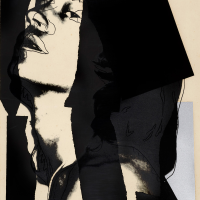15. ANDY WARHOL

Andy Warhol is arguably the most important contemporary artist of the twentieth century. The reasons are as many as they are various but perhaps the most significant is Warhols use of serial imagery. By 1956, artists in London and New York were drawing upon popular media for their paintings, sculpture, and prints. The term Pop, first coined in 1958 by Laurence Alloway, quickly became an idea that ignited contemporary imagery in the minds of artists, critics, and collectors.
Andy Warhol was well placed as an illustrator and by temperament, as an observer of contemporary society. Warhol understood repetition and the part advertising played in modern life. He famously said he had the same lunch of Campbells Tomato Soup every day for 20 years. In turn, in August 1962, Warhol exhibited 32 Campbells Soup Can paintings at the Ferus Gallery in Los Angeles. The paintings were arranged simply along shelves: one Chicken, one Cheese, one Chilli Beef, one Green Pea. Why have one when you can have many versions of the same thing? 1962 was also the year that Warhol, with his contemporary, Robert Rauschenberg (1925-2008), discovered photo silk-screen printing. Screen printing was the perfect medium for reproduction and multiples. It was all so simple, as Warhol described it, quick and chancy. I was thrilled by it.1
Mick Jagger is one of ten images from the Mick Jagger portfolio that Warhol completed in 1975. Jagger is portrayed in ten different poses rather than a single image completed in different colourways. The photographs of Jagger were taken by Warhol and as there were a large number, Warhol had no need of a stock image. Warhol began to use blocks of paper to create a collage-like effect, a technique he put to good use in the Jagger suite, but also in subsequent series.
The photograph for the print was one of the strongest to hand. Jagger has the assuredness of the complete performer. No one has his moves or the profile-pout the image captures. Warhol posed Jagger against a neutral ground using flash to deeply etch the singers head. Brightness flattens and rarely flatters, but Warhol makes a virtue of this. He uses line and a patch of silver, at bottom right, to support the image and to bring it home.
Mick Jagger is part of the enduring relationship that Warhol and Jagger shared in the pantheon of fame. Image is the precondition of this alliance and Mick Jagger is the very moment where image-maker and artist meet.
Footnote:
1. Andy Warhol quoted in Foster, H., The First Pop Age, Princeton University Press, United States of America, 2012, p.120
Brett Ballard